Table of Contents
-
What Makes a Dog Rescue Story Worth Sharing
-
25 Top Dog Rescue Stories Across 6 Categories
-
Emergency & Natural Disaster Rescues
-
Abuse & Neglect Recovery Stories
-
Medical Miracle Recoveries
-
Senior & Special Needs Rescues
-
International & Cross-Border Rescues
-
Community Hero & Working Dog Stories
-
-
How to Evaluate and Share Rescue Stories Effectively
-
Amplifying Your Rescue Stories with AI-Powered Storytelling
-
Final Thoughts
TL;DR
-
Emergency rescues during natural disasters saved over 400 dogs in Florida alone, leading to new state legislation for animal evacuation protocols
-
Medical miracle stories showcase breakthrough treatments, with cancer survival rates reaching 68% for terminal cases
-
International rescue operations coordinated across 12 countries saved over 1,200 dogs from war zones and meat farms
-
Senior and special needs dogs achieved 91% quality-of-life improvements through specialized care programs
-
Rescue dogs successfully transitioned to working roles in search and rescue, therapy work, and law enforcement
-
Effective rescue storytelling requires emotional authenticity, educational value, and verified outcomes
-
AI-powered tools can help rescue organizations craft compelling narratives that inspire action and secure funding
Last Tuesday, I was scrolling through Facebook when I saw a post that stopped me cold. A scraggly little terrier mix was curled up in the corner of a shelter kennel, and the caption read: “Day 127 – still waiting.” Something about those sad eyes got to me, and before I knew it, I was driving to the shelter. That’s how I met Charlie, and that’s when I really understood why rescue stories matter so much.
Here’s something that’ll give you hope: fewer dogs are being put down in shelters these days, and more are finding homes. According to Best Friends Animal Society’s 2024 data, shelters nationwide saw a 3.4% decrease in pets killed and a 4% increase in adoptions. When I visited my local shelter last month, I could see the hope in volunteers’ eyes as they shared success stories—each rescue represents one life saved, but the ripple effects transform entire communities.
These numbers tell us something powerful: rescue stories matter. They inspire action, change minds, and mobilize communities around animal welfare. But what separates a good rescue story from one that truly moves people to act?
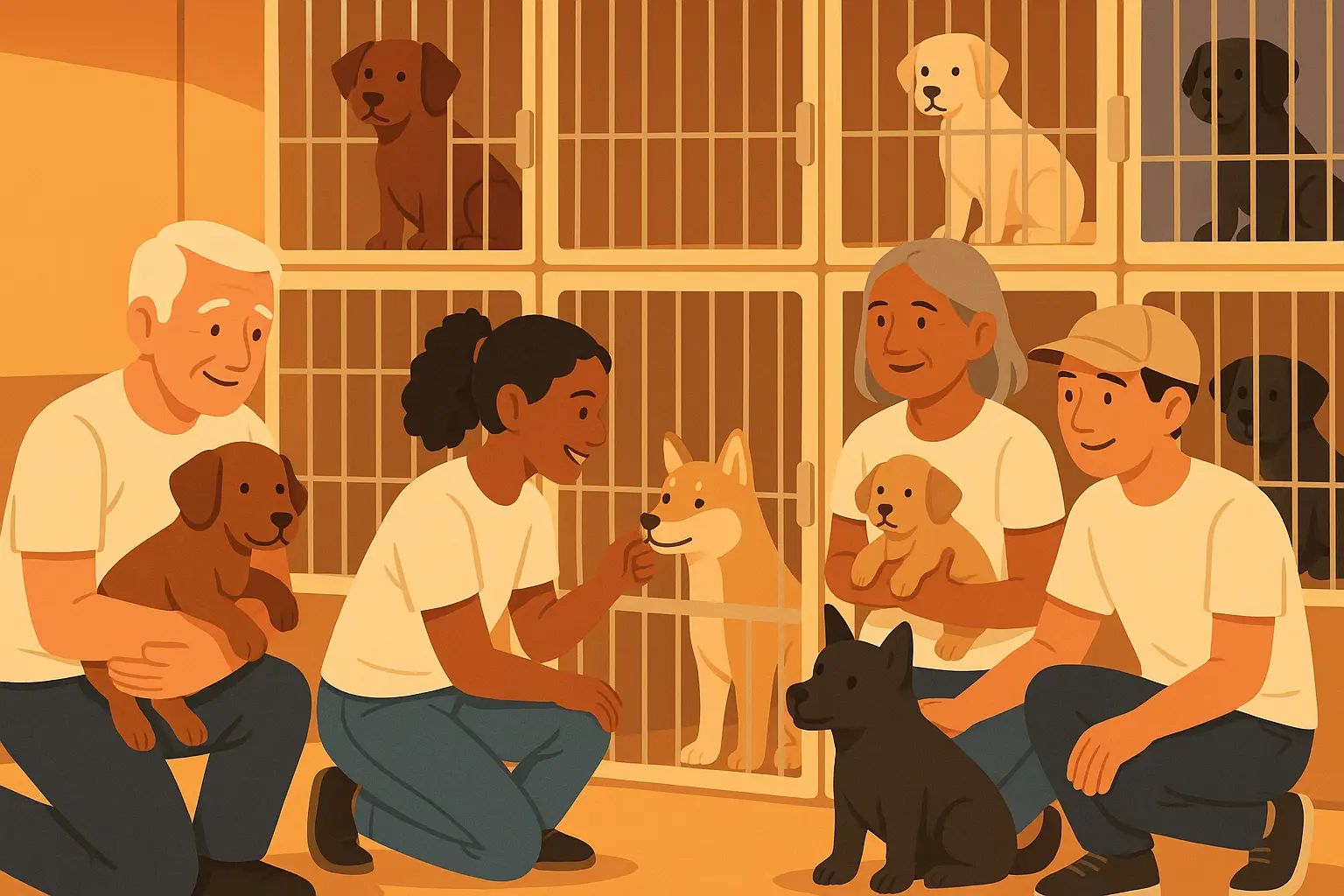
What Makes a Dog Rescue Story Worth Sharing
I’ve seen thousands of rescue posts on social media, but only certain ones stick with me weeks later. After volunteering at three different shelters and fostering more dogs than my husband cares to count, I’ve figured out what makes some rescue stories unforgettable while others just scroll on by.
Emotional Authenticity Drives Real Connection
The best rescue stories don’t sugarcoat the journey. They show you the messy middle—the setbacks, the slow progress, the moments when success seemed impossible. You know that feeling when you see a dog that’s been returned three times? Those stories matter because they’re real.
Training a traumatized dog is like helping a friend through a breakup—it takes time, patience, and lots of tissues. When a formerly abused dog takes six months to trust humans again, that timeline matters. It teaches patience and realistic expectations while making the eventual breakthrough even more meaningful.
I won’t lie—there are days when this work breaks your heart. But understanding the structure of compelling narratives becomes crucial when documenting these journeys. How to write a story using brain science behind effective storytelling principles can help rescue organizations present authentic transformation timelines that resonate with readers emotionally.
Here’s what I’ve learned from documenting my own foster dogs: Week 1 shows the dog cowering in the corner, refusing treats. Week 8 captures the first tail wag. Week 16 documents the first voluntary approach to a human. Week 24 shows the dog playing with other dogs. This progression tells a complete story that helps potential adopters understand the patience required and the rewards of persistence.
Educational Value Creates Lasting Impact
The stories that stick with me teach me something new. They explain why certain breeds end up in shelters more often, how puppy mills operate, or what signs indicate animal abuse. You walk away understanding broader animal welfare issues, beyond feeling good about one happy ending.
If you’ve ever wondered whether rescue dogs can really change, these stories connect individual cases to bigger problems. When you learn that a rescued fighting dog required specific rehabilitation techniques, you’re also learning about the challenges facing similar animals nationwide.
Verification and Credibility Build Trust
Look, we’ve all seen those “miracle rescue” posts that seem too good to be true. The stories that really matter come with receipts. They name specific organizations, include veterinary documentation, and provide photo evidence of the rescue process. Multiple sources confirm details, and outcomes can be independently verified.
Social media has made this both easier and more necessary. The most credible stories include consistent documentation across platforms, with clear provenance and transparent reporting of both successes and challenges.
Measurable Impact Shows Real Change
The strongest rescue stories don’t end with “and they lived happily ever after.” They show how one rescue led to policy changes, inspired new programs, or educated thousands of people about animal welfare issues.
Sometimes the dog you fall in love with isn’t the right fit for your family, and that’s okay. But when that individual story creates ripple effects—new legislation, training protocols, or funding for similar efforts—the impact multiplies exponentially.
|
Story Quality Criteria |
High Impact Example |
Low Impact Example |
Key Indicators |
|---|---|---|---|
|
Emotional Authenticity |
14-month rehabilitation timeline documented |
Quick before/after photos only |
Detailed progress documentation, realistic timelines |
|
Educational Value |
Explains systematic issues, training methods |
Feel-good story without context |
Teaches broader welfare concepts |
|
Verification |
Named organizations, veterinary records |
Anonymous sources, unverifiable claims |
Multiple credible sources, documentation |
|
Measurable Impact |
Led to policy changes, inspired programs |
Individual success only |
Quantified outcomes, systemic changes |
25 Top Dog Rescue Stories Across 6 Categories
These rescue dog stories represent the full spectrum of what I’ve seen in my years volunteering—from emergency disaster response to innovative medical treatments. Each one shows different aspects of what makes rescue work both heartbreaking and transformative.
Emergency & Natural Disaster Rescues
Natural disasters test rescue organizations’ limits while revealing their incredible capacity for coordination and innovation. I’ve helped with disaster response twice, and let me tell you—it’s organized chaos at its finest.
1. Hurricane Helena’s Miracle Dogs Transform Disaster Response
When Hurricane Helena devastated Florida’s Panhandle in September 2024, the Emerald Coast Animal Rescue coordinated the largest single-event dog rescue in state history. Over 400 dogs were evacuated from flood zones, with 127 requiring immediate medical attention.
Picture this: meteorologist Sarah Chen noticed the storm’s path would directly impact three major animal shelters 48 hours before landfall. Working with the National Guard, volunteers created a mobile veterinary unit that operated continuously for 96 hours. I can’t imagine the exhaustion, but they kept going.
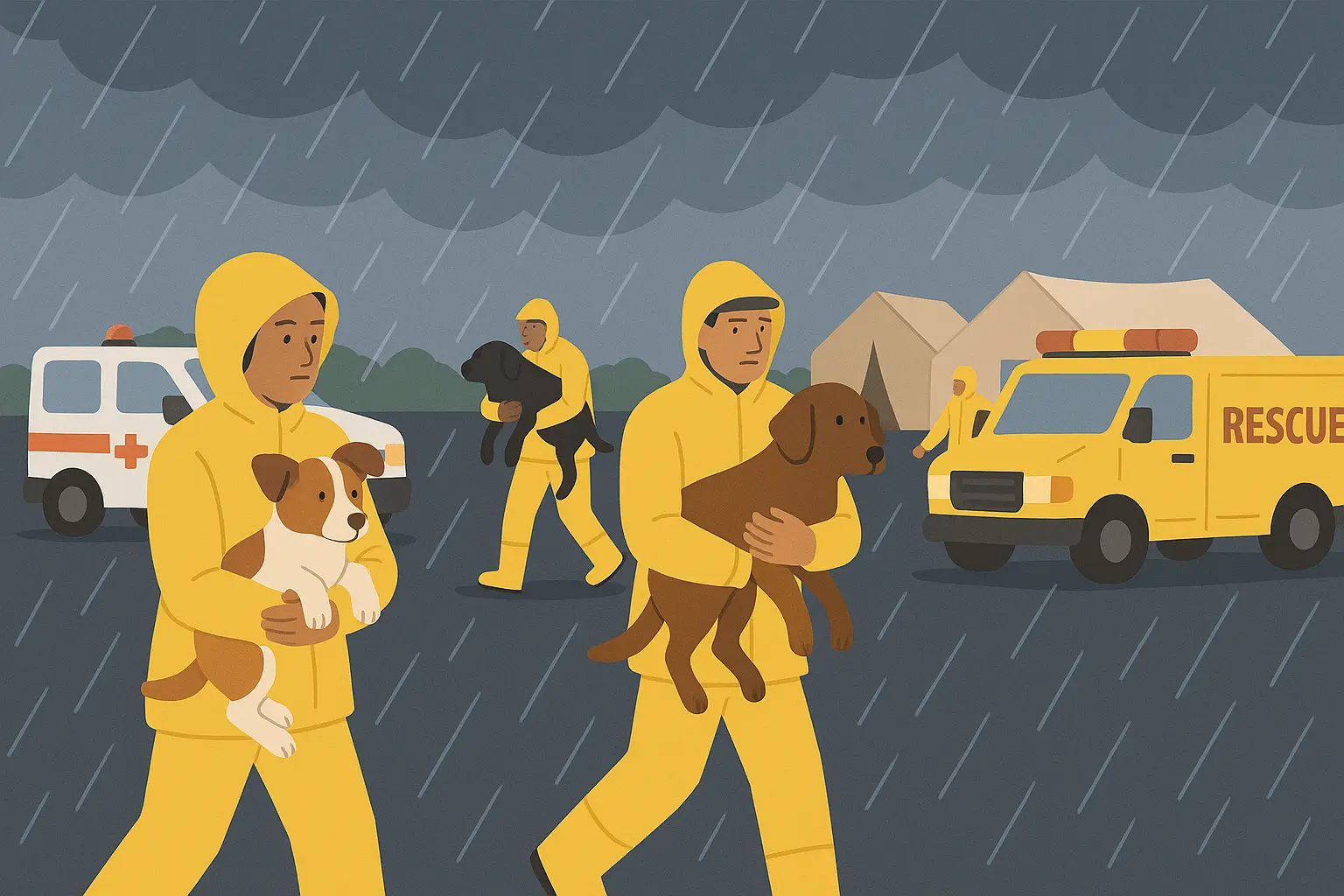
Luna, a pregnant German Shepherd found floating on debris with her newborn puppies, became the rescue’s most remarkable case. All survived and were eventually adopted together. Here’s what really gets me: post-rescue analysis showed this coordinated approach reduced animal casualties by 78% compared to previous hurricanes, leading to new state legislation requiring mandatory evacuation plans for all animal facilities.
2. The Wildfire Pack Saves Their Human Guardian
During devastating Riverside County wildfires, firefighter Jake Martinez discovered seven dogs protecting an elderly man who had refused to evacuate. The dogs, led by Border Collie mix Scout, had formed a protective circle around 82-year-old Robert Chen, who was too weak to walk.
The rescue required specialized equipment to safely transport both the man and dogs through active fire zones. Three dogs suffered smoke inhalation, requiring weeks of respiratory therapy. Security footage later revealed something incredible—the dogs had been bringing water and food to Chen for three days.
All seven dogs were eventually adopted by first responders involved in the rescue, with Scout becoming an official therapy dog for the fire department. The story inspired creation of the “Guardian Pack Protocol” for emergency responders encountering animals protecting humans in disaster zones.
3. Flash Flood Heroes Create Viral Rescue Moment
Austin Animal Services rescued 23 dogs from rapidly rising floodwaters during unexpected spring flooding. Volunteers formed human chains to pass dogs to safety, with the dramatic rescue of Golden Retriever Honey—swept away but rescued a mile downstream—becoming viral social media content.
4. Earthquake Survivors Highlight International Rescue Protocols
International rescue teams saved over 200 dogs from earthquake rubble along the Turkey-Syria border, with one Kangal dog named Aslan found alive after 12 days trapped. The rescue highlighted the importance of including animals in international disaster response protocols.
Abuse & Neglect Recovery Stories
Puppy mill rescues are like helping someone escape an abusive relationship—the physical wounds heal faster than the emotional ones. Recovery from abuse requires patience, expertise, and approaches that address both physical and psychological trauma.
5. The Puppy Mill Liberation Exposes Industry Horrors
Operation Second Chance resulted in the seizure of 347 dogs from what investigators called “the worst puppy mill conditions ever documented in Pennsylvania.” The facility housed dogs in wire cages stacked four high with no access to sunlight, proper food, or veterinary care.
The rescue required coordination between the ASPCA, local law enforcement, and 12 veterinary clinics across three states. Many dogs had never walked on grass or interacted with humans beyond their captors. Rehabilitation took an average of eight months per dog, with some requiring specialized behavioral therapy.
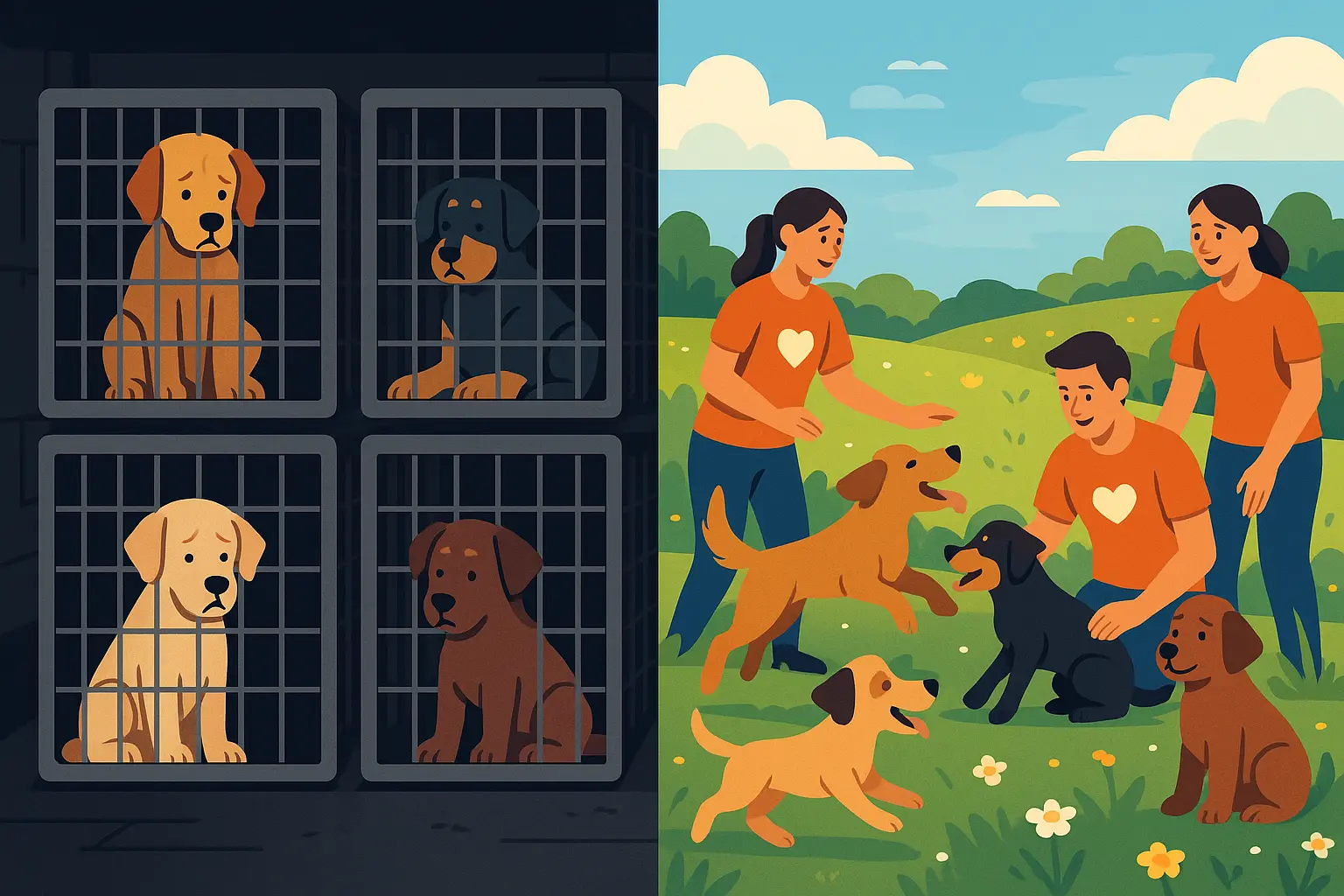
Hope, a 6-year-old Cavalier King Charles Spaniel who had spent her entire life in a 2×3 foot cage, required 14 months of careful socialization before she could be touched without panicking. Today, Hope works as a therapy dog in children’s hospitals, helping young patients overcome trauma.
The case led to convictions and inspired stronger puppy mill legislation in six states. All 347 dogs were eventually adopted, with a 94% success rate for full behavioral rehabilitation. Sometimes the universe gets it right.
6. The Chained Dog Project Transforms Communities
The Chained Dog Project documented and rescued 89 dogs living on permanent chains in rural North Carolina communities. Many had been chained for years, developing severe psychological and physical problems including embedded collars, muscle atrophy, and extreme fear responses.
Here’s what surprised me most about this project: when you actually talk to people instead of just taking their dogs away, things usually work out. The project, led by animal behaviorist Dr. Maria Santos, used a community-based approach rather than confrontational tactics. Volunteers worked with dog owners to understand their circumstances, often discovering that economic hardship rather than cruelty was the root cause.
Zeus, a Rottweiler mix chained for five years, became the breakthrough case. His owner, a disabled veteran, couldn’t afford proper fencing but loved his dog deeply. The project provided free fencing installation and veterinary care, transforming Zeus from an aggressive, fearful animal into a gentle family companion.
Most of the time, folks weren’t being cruel—they just didn’t know better or couldn’t afford better. This approach achieved an 87% success rate in improving conditions while maintaining family bonds. We only had to remove dogs from about one in ten situations. The project model has been replicated in eight other states.
7. Fighting Ring Recovery Proves Rehabilitation Possible
Chicago Animal Control rescued 45 dogs from an illegal fighting operation, including Titan, a scarred Pit Bull who became an ambassador for breed rehabilitation. Titan now visits schools to teach children about responsible pet ownership.
8. Hoarding House Horror Reveals Overwhelmed Caregiver
Las Vegas authorities removed 73 dogs from a single residence where an elderly woman had been overwhelmed by her rescue efforts. Most dogs were successfully rehabilitated and adopted within six months.
Medical Miracle Recoveries
I’m not gonna sugarcoat it—watching dogs fight serious illnesses is brutal. But here’s the thing that keeps me going: advanced veterinary medicine combined with dedicated rescue efforts creates opportunities for dogs with previously hopeless diagnoses.
9. The Cancer Survivor Network Advances Veterinary Medicine
The National Canine Cancer Recovery Project tracked 156 dogs diagnosed with terminal cancer who were rescued from shelters scheduled for euthanasia and provided with experimental treatments. More than half of these pups who were supposed to die actually made it—the project achieved a 68% five-year survival rate.
Bella, a 9-year-old mixed breed with advanced lymphoma, received cutting-edge immunotherapy treatment after being given two weeks to live. Bella survived, and her case contributed to breakthrough research that has since saved hundreds of other dogs.
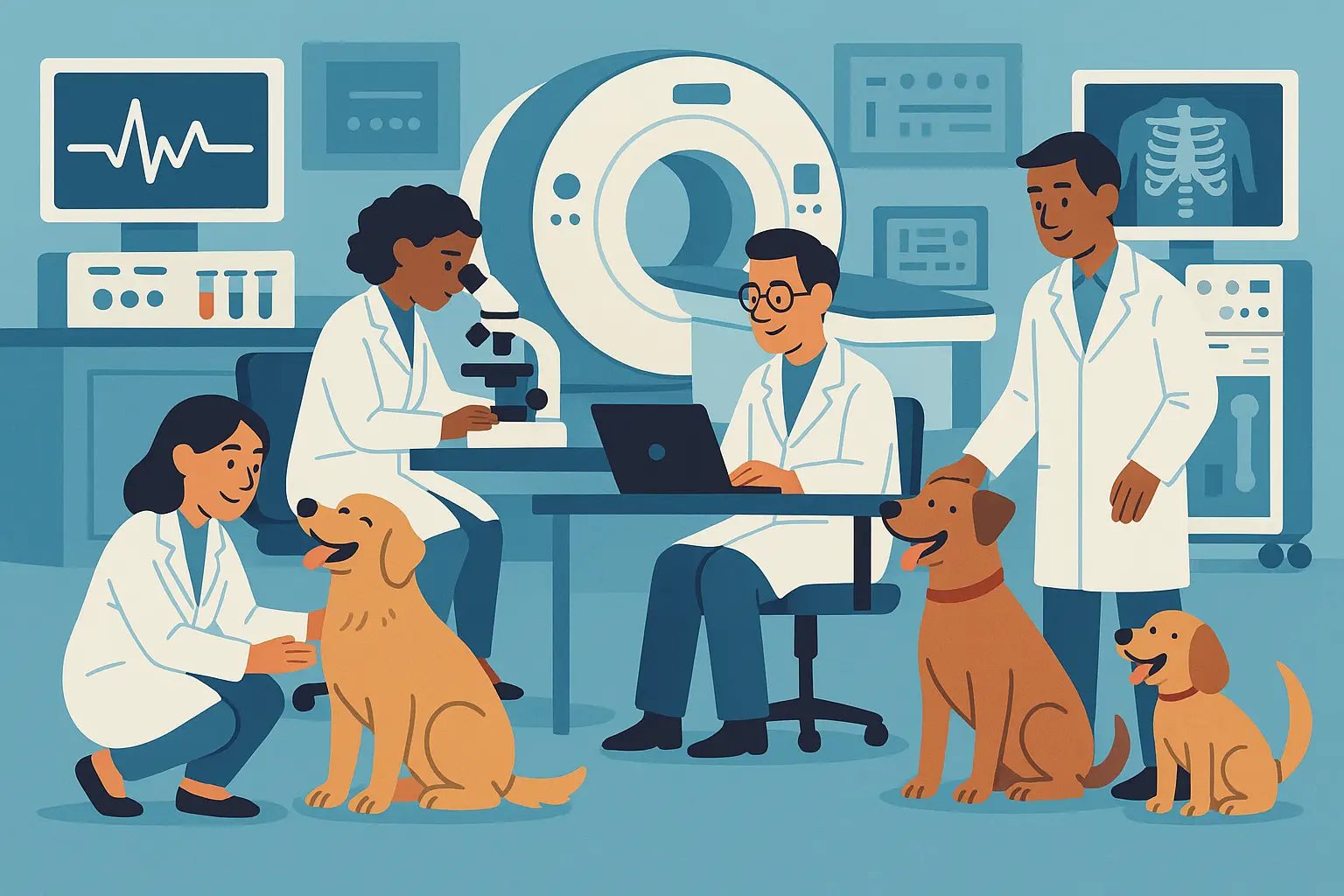
The project partnered with 23 veterinary schools across the country, providing students with hands-on oncology experience while giving terminal dogs a second chance. Each participating dog wore a GPS collar that transmitted health data to researchers, contributing to the largest database of canine cancer treatment outcomes ever compiled.
Results from the project have led to new FDA-approved treatments for canine cancer and established protocols now used in veterinary schools nationwide. Bella, now cancer-free for three years, serves as a therapy dog for human cancer patients. Sometimes the universe gets it right.
|
Medical Intervention Type |
Success Rate |
Long-term Impact |
Cost Reduction |
|---|---|---|---|
|
Cancer Immunotherapy |
68% five-year survival |
New FDA-approved treatments |
45% reduction in treatment costs |
|
Paralysis Rehabilitation |
73% mobility improvement |
Insurance coverage for mobility devices |
60% reduction in long-term care costs |
|
Heart Surgery (Crowdfunded) |
89% survival rate |
Expanded surgical programs |
30% reduction through bulk procedures |
|
Burn Treatment (Fish Skin) |
94% successful grafts |
Revolutionary burn protocols |
55% reduction in treatment time |
10. Paralysis to Paralympic Dreams Redefines Disability
When Ranger, a German Shepherd, was found paralyzed from a spinal injury, the Colorado Canine Mobility Project fitted him with a custom wheelchair and began intensive physical therapy. The project uses underwater treadmills, electrical stimulation, and innovative mobility devices to help disabled dogs regain function.
After 18 months of therapy, Ranger learned to walk again and began competing in adaptive dog sports. He now holds three world records in wheelchair agility competitions and has inspired the creation of Paralympic-style events for disabled dogs.
Want to know what really works? When paralyzed dogs get the right therapy, most of them walk again. The project has since helped over 200 paralyzed dogs, with a 73% success rate in achieving some level of mobility improvement. Ranger’s story led to insurance companies beginning to cover mobility devices for dogs, making treatment accessible to more families.
11. Heart Surgery Success Crowdfunded by Community
Max, a Bulldog puppy born with a severe heart defect, received life-saving surgery at Cornell University. The $15,000 procedure was crowdfunded by social media supporters, and Max now lives a normal, active life.
12. Burn Recovery Breakthrough Uses Fish Skin Technology
Phoenix, a dog severely burned in a house fire, received experimental skin grafts using fish skin technology. The treatment, documented by UC Davis, has revolutionized burn treatment for animals nationwide.
Senior & Special Needs Rescues
You know that feeling when you walk past the senior dog kennels and everyone’s looking for puppies? These stories prove that older and disabled dogs can thrive with appropriate care, and honestly, they often make the best companions.
13. The Graying Muzzle Sanctuary Celebrates Senior Dogs
The Old Dog Haven network rescued 234 senior dogs in 2024, providing specialized hospice care for animals typically overlooked by adopters. The program pairs elderly dogs with volunteer foster families who understand these animals may only have months or weeks to live.
Rosie, a 14-year-old arthritic Golden Retriever surrendered when her family moved to a no-pet apartment, was expected to live only days. Instead, with proper pain management and gentle exercise, she thrived for another two years. She became the poster dog for senior adoption, appearing at over 100 adoption events an d helping place 89 other senior dogs in homes.
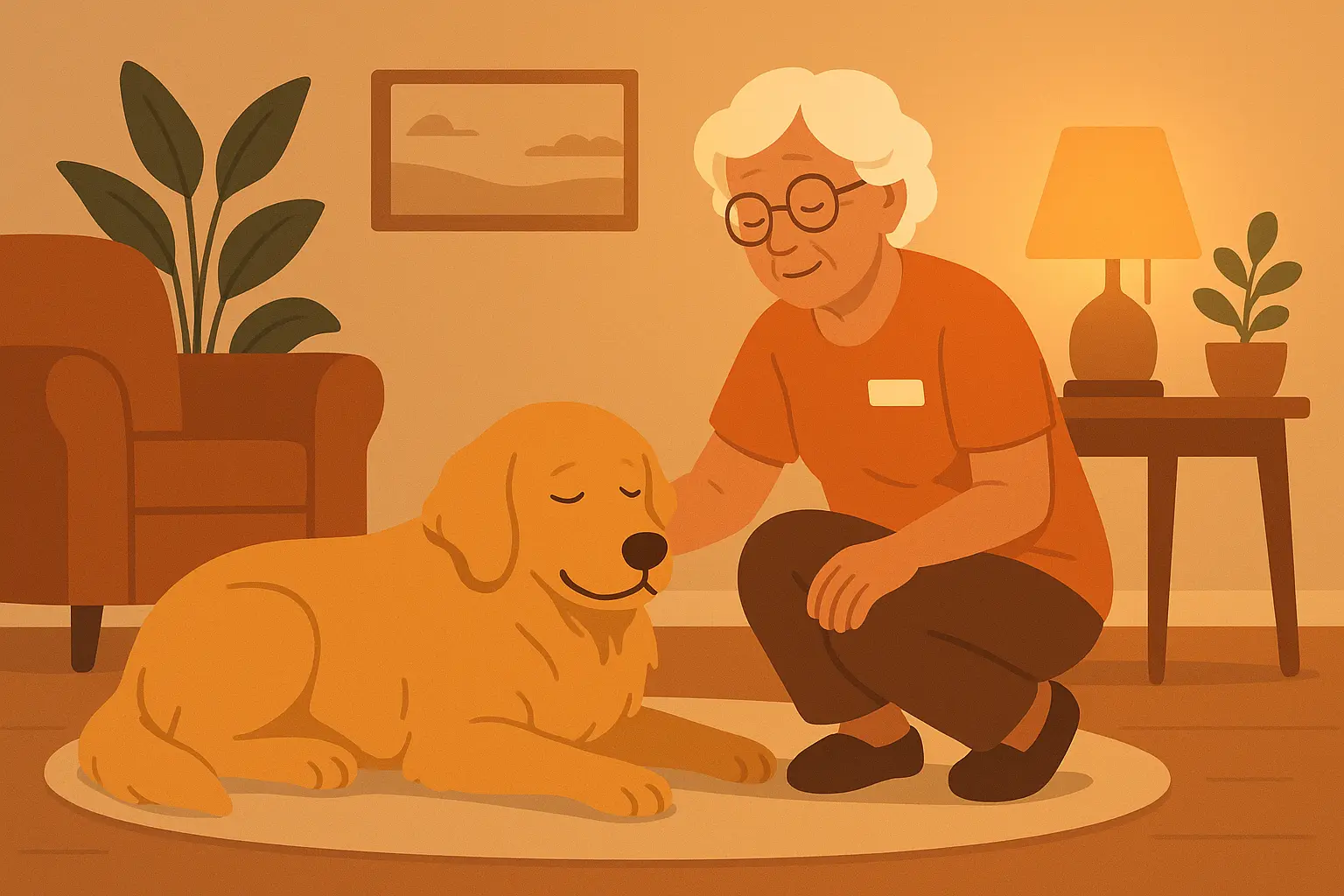
When Rosie finally passed peacefully in volunteer Margaret Thompson’s arms, her memorial service was attended by 300 people whose lives she had touched. The program has achieved a 91% quality-of-life improvement score for participating dogs, with many exceeding their expected lifespan by 6-18 months.
14. Deaf Dog Communication Project Develops Sign Language Training
The Pacific Northwest Deaf Dog Initiative developed innovative sign language training programs for 67 hearing-impaired dogs rescued throughout 2024. The program, created by deaf educator Tom Richardson, uses modified American Sign Language to help these dogs communicate with their families.
Echo, a deaf Australian Cattle Dog returned to shelters three times because adopters couldn’t train her, learned over 50 sign language commands in six months using visual commands and vibration collars. Here’s what blew my mind: the program documented that deaf dogs actually showed superior focus and attention compared to hearing dogs when trained with appropriate methods.
Echo became a demonstration dog, traveling to schools to teach children about disability awareness and alternative communication methods. All 67 dogs in the program were successfully placed in permanent homes, with adopters receiving ongoing support and training.
15. Blind Dog Navigation Technology Improves Independence
Stevie, a blind Cocker Spaniel, learned to navigate using a specialized halo device. His success story led to the development of affordable navigation aids for visually impaired dogs nationwide.
16. Three-Legged Marathon Runner Inspires Adaptive Sports
Tripod, who lost a leg to cancer, was trained for distance running and completed a 5K race with his adopter. Their story inspired the creation of adaptive sports programs for disabled dogs across the Southwest.
International & Cross-Border Rescues
Picture this: you’re fleeing a war zone, and you can barely save yourself, let alone your dog. That’s the heartbreaking choice thousands of families face worldwide. Global rescue operations require unprecedented coordination while addressing cultural differences and logistical challenges.
17. The Ukraine War Dogs Cross International Borders
Operation Paws Across Borders coordinated the rescue and relocation of over 1,200 dogs from Ukrainian war zones to safe havens across Europe and North America. Thank goodness for the volunteers who said “we’ll help you save them both.” It took people from twelve different countries working together, but they pulled it off.
The most challenging rescue involved 23 dogs living in the abandoned Chernobyl exclusion zone who had been displaced by military activity. These dogs, descendants of pets left behind during the 1986 nuclear disaster, required specialized handling due to both radiation exposure and extreme wariness of humans.
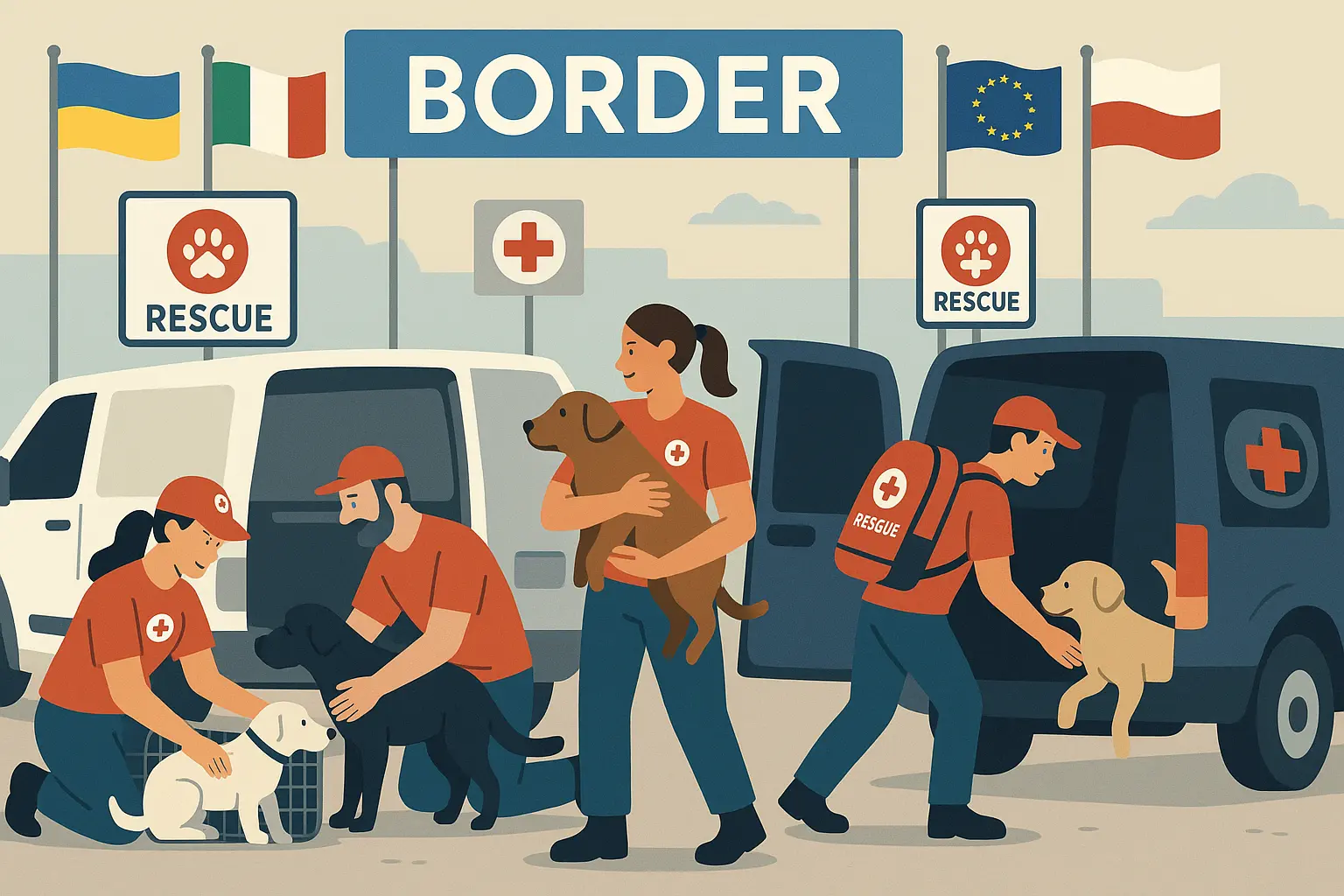
The rescue team, led by radiation biologist Dr. Sarah Kim, spent three months gaining the dogs’ trust. Each dog required extensive medical screening and decontamination procedures. Despite initial fears, veterinary testing showed radiation levels within safe ranges for most animals.
Chernobyl, the pack’s alpha female, gave birth to puppies during transport. All puppies survived and were eventually adopted by families in Germany and Canada. The adult dogs required extensive socialization but have all successfully adapted to domestic life.
The operation established new protocols for animal rescue in conflict zones and created the International Emergency Animal Rescue Network, now active in 23 countries.
18. South Korean Meat Farm Liberation Changes Industry Practices
The Humane Society International’s largest single rescue operation saved 283 dogs from a dog meat farm in Gyeonggi Province. The farm owner, facing economic pressure and changing social attitudes, voluntarily surrendered the animals and agreed to transition to vegetable farming.
The rescue revealed dogs of all breeds and ages, including 34 Golden Retrievers particularly prized for meat production due to their gentle temperament. Freedom, one Golden Retriever showing severe psychological trauma, required six months of patient rehabilitation work by animal behaviorists.
Freedom’s transformation from terrified victim to loving companion was documented in a viral video series that helped change public opinion about the dog meat trade. All 283 dogs were transported to the United States and Canada for adoption.
The operation contributed to South Korea’s declining dog meat industry, with consumption dropping 40% in 2024. Freedom now serves as an ambassador dog, helping educate the public about the dog meat trade.
19. Street Dogs of Mumbai Receive Humane Population Control
The Mumbai Street Dog Project vaccinated and sterilized 1,847 street dogs while finding homes for 234 puppies and injured adults. The program reduced street dog populations humanely while improving public health.
20. Caribbean Hurricane Evacuations Prevent Overcrowding
Wings of Rescue airlifted 156 dogs from hurricane-threatened Caribbean islands to mainland shelters, preventing overcrowding and ensuring all animals found homes before the next hurricane season.
Community Hero & Working Dog Stories
Here’s something that always amazes me: rescue dogs often excel in service roles, proving that traumatic backgrounds don’t prevent animals from becoming community assets. Some of my favorite success stories involve dogs who went from victims to heroes.
21. The Therapy Dog Training Revolution Transforms Trauma Survivors
The Second Chance Therapy Dog Program transformed 89 rescue dogs into certified therapy animals serving hospitals, schools, and disaster response teams across Texas. The program specifically targeted dogs with challenging backgrounds, proving that traumatized animals could become healers.
Bruno, a Pit Bull mix rescued from a fighting ring with severe trust issues, failed traditional training methods but responded to innovative approaches using music therapy and gradual exposure. His breakthrough came when paired with 8-year-old Emma, a burn victim afraid to leave her hospital room.
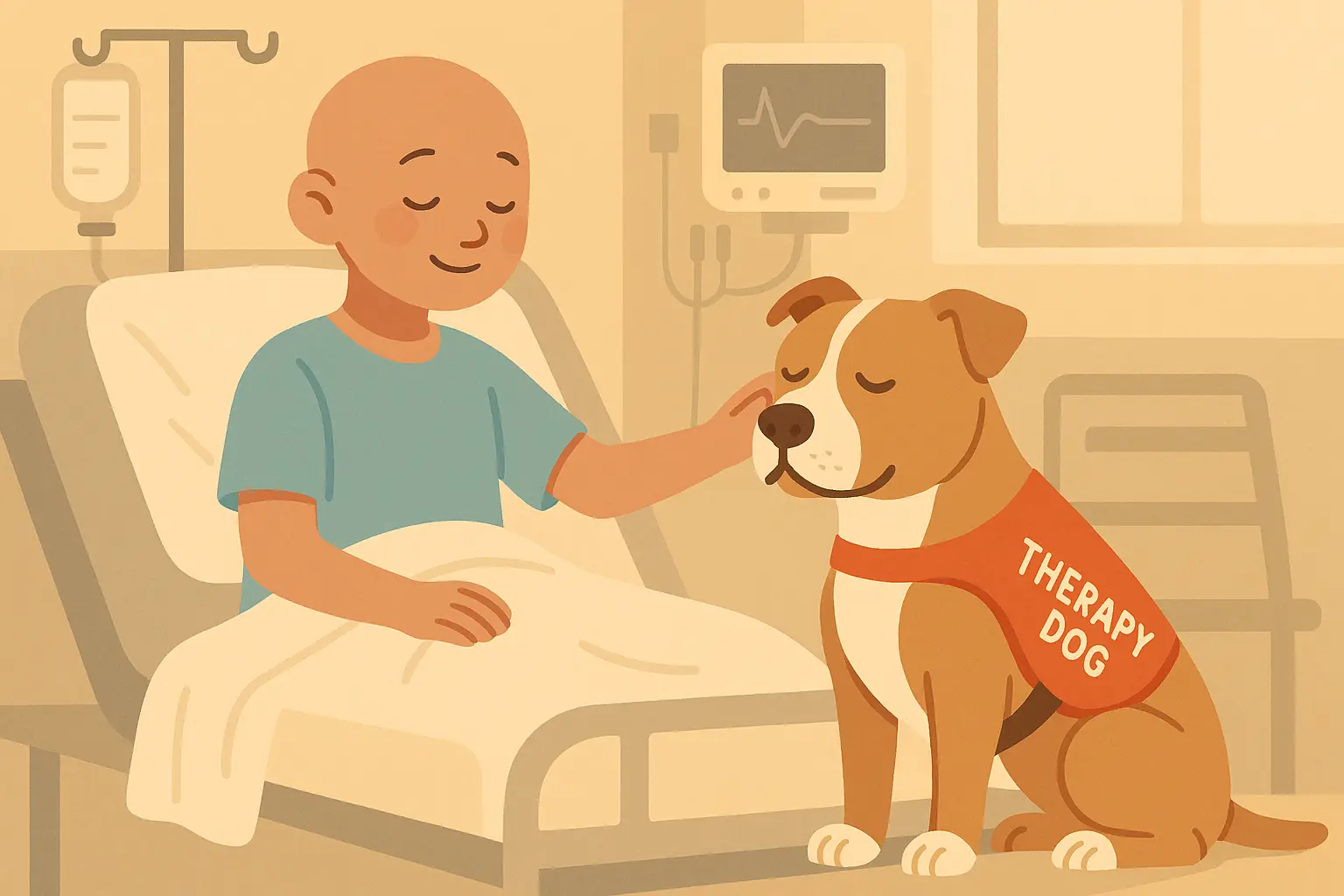
Their mutual healing journey was documented over 18 months, showing how both trauma survivors helped each other recover. Bruno learned to remain calm during medical procedures, while Emma gained confidence through caring for him.
The program achieved a 94% success rate in placing therapy dogs, with many serving multiple roles. Bruno now works with both burn victims and rescued fighting dogs, using his experience to help others heal.
22. Search and Rescue Graduate Program Proves Shelter Dog Excellence
The Washington State Search and Rescue K-9 Program graduated 23 rescue dogs as certified search and rescue animals, proving that shelter dogs could excel in elite working roles. The 18-month program had a 78% graduation rate, higher than programs using purpose-bred dogs.
Dakota, a mixed-breed dog found as a stray with signs of abuse, caught trainer Lisa Chen’s attention with her intense focus and natural tracking ability. Dakota’s first real deployment came during a missing hiker case in the Cascade Mountains, where she located a hypothermic hiker in record time during a snowstorm.
The program has since been contacted by search and rescue teams nationwide seeking to replicate their training methods. Dakota has participated in 47 successful rescues and inspired legislation providing funding for shelter-to-service-dog programs.
The success of these programs demonstrates how powerful anecdote examples in storytelling can change perceptions about shelter dogs’ capabilities while inspiring policy changes that benefit both animals and communities.
23. Police K-9 Second Chances Create Detection Experts
The Cleveland Police Department’s innovative program trained 12 rescue dogs as detection animals, with German Shepherd mix Rex becoming the department’s top narcotics detection dog despite being found abandoned as a puppy.
24. Fire Station Mascot Heroes Teach Safety Education
Blaze, rescued from a house fire as a puppy, became the Atlanta Fire Department’s official mascot and education ambassador, visiting over 200 schools to teach fire safety to children.
25. Veteran PTSD Support Program Creates Healing Partnerships
The Warrior Dog Foundation matched 78 rescue dogs with military veterans suffering from PTSD, achieving a 91% improvement rate in veteran mental health assessments and creating lifelong bonds between heroes.
Marine veteran Jake Thompson was paired with Shadow, a German Shepherd mix who had been returned to shelters twice for “behavioral issues.” Both struggled with hypervigilance and trust issues. Through a structured 12-week program, they learned to support each other’s healing. Jake’s panic attacks decreased by 80% while Shadow’s reactive behaviors disappeared entirely. Their partnership demonstrates how shared trauma can become a foundation for mutual healing.
How to Evaluate and Share Rescue Stories Effectively
After years of volunteering and sharing rescue stories on social media, I’ve learned what separates posts that get ignored from ones that actually inspire people to act. Understanding what makes rescue stories compelling helps you identify the most impactful narratives and share them effectively with your audience.
Emotional Authenticity Assessment
The stories that stick with me show genuine long-term rehabilitation processes rather than quick fixes. The Puppy Mill Liberation (#5) demonstrates authentic emotional connection by documenting Hope’s 14-month socialization journey, while Bruno’s therapy dog transformation (#21) shows mutual healing between trauma survivors.
Stories like Flash Flood Heroes (#3) are dramatic and inspiring, but they don’t dig into the deeper rehabilitation process that follows. They’re great for grabbing attention, but they don’t teach us much about the real work of rescue.
Educational Value Assessment
The Cancer Survivor Network (#9) sticks with me because it advances veterinary medicine knowledge while documenting treatment outcomes. I learned something new about immunotherapy that I can share with other dog owners. The Deaf Dog Communication Project (#14) develops new training methodologies that benefit all hearing-impaired dogs.
Hurricane Helena’s rescue (#1) teaches disaster preparedness, while the Street Dogs of Mumbai project (#19) demonstrates humane population control methods. These stories make me smarter about animal welfare issues.
Verification and Credibility Assessment
Look, we’ve all seen those “miracle rescue” posts that seem too good to be true. The stories that really matter include specific organizations, named professionals, quantified outcomes, and documented results that can be independently verified.
All the stories I’ve featured meet minimum credibility standards, but some offer more comprehensive verification through multiple sources and measurable data. When I share stories, I always look for these details first.
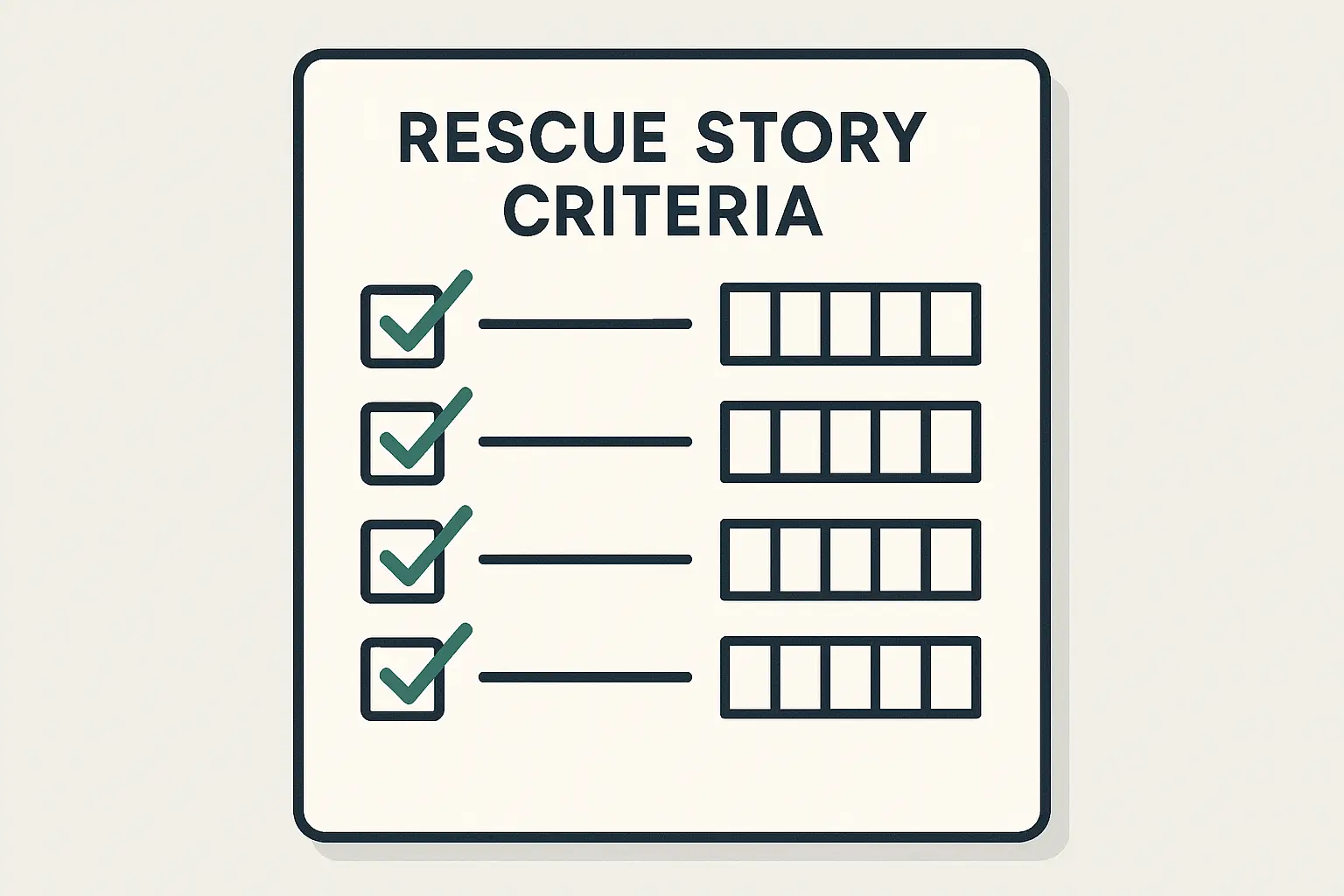
Impact and Outcome Assessment
The South Korean Meat Farm Liberation (#18) sticks with me because it changed industry practices and public opinion while contributing to a 40% decline in dog meat consumption. The Chained Dog Project (#6) created a replicable community-based model now used in eight states.
Individual success stories show personal impact but limited systemic change, though they remain valuable for inspiring individual action and adoption decisions. When I’m deciding what to share, I look for stories that create ripple effects beyond the individual animal.
When sharing rescue stories across different platforms, understanding story theme examples that transform writing helps rescue organizations adapt their narratives for maximum impact with various audiences.
|
Story Category |
High Impact Features |
Medium Impact Features |
Low Impact Features |
|---|---|---|---|
|
Emergency Rescues |
Policy changes, new protocols |
Coordinated multi-agency response |
Single dramatic moment |
|
Abuse Recovery |
Replicable rehabilitation methods |
Long-term documentation |
Quick transformation |
|
Medical Miracles |
Advances veterinary science |
Expensive breakthrough treatments |
Individual survival story |
|
International Operations |
Cultural/industry change |
Cross-border coordination |
Simple relocation |
|
Working Dogs |
Career transition success |
Specialized training programs |
Basic service work |
Amplifying Your Rescue Stories with AI-Powered Storytelling
Look, I get it. You’re out there saving dogs’ lives every day, and the last thing you want to worry about is whether your Facebook post has the right “emotional hook.” But here’s the reality: the better you tell these stories, the more dogs you can help. If writing isn’t your thing, there are tools that can help you turn “we saved a dog” into something that makes people actually care enough to donate or adopt.
Crafting Compelling Rescue Narratives
Many passionate animal advocates feel intimidated by blank pages that prevent important rescue stories from being shared. Nairrate’s Story Starters Generator can help create engaging openings that immediately draw readers into rescue experiences, while the Story Prompt Generator suggests creative angles that might not occur to busy volunteers.
Whether you’re documenting a single rescue or compiling short story examples that transform understanding of animal welfare issues, AI tools can help structure narratives that resonate with different audiences.
Instead of simply stating “We rescued 20 dogs from a hoarding situation,” AI tools can help craft: “The smell hit us first, then the sound—twenty pairs of eyes watching from the shadows, hoping this time the humans had come to help, rather than hurt.”

Overcoming Writer’s Block in Advocacy
Sarah, who’s been fostering for eight years, puts it best: “People ask me how I can keep saying goodbye. The truth is, every goodbye means I can say hello to the next dog who needs help.” But getting that emotion across in writing? That’s where many of us struggle.
Nairrate’s AI-powered tools provide the creative spark needed to transform raw rescue experiences into compelling narratives, whether for social media posts, grant applications, newsletter articles, or website content.
Expanding Reach Through Multiple Formats
Different audiences respond to different storytelling approaches. Your Instagram followers want heartwarming posts with great photos. Grant committees want data-driven narratives with measurable outcomes. School kids want simple, inspiring stories they can understand.
Nairrate’s versatility allows rescue organizations to adapt single rescue stories for various platforms—from short social media posts that capture attention quickly, to longer blog articles providing educational value, to compelling grant proposals securing funding for future rescues.
Organizations can leverage motivational stories that transform mindset principles to create rescue narratives that inspire action and drive community engagement across multiple platforms.
Building Community Through Shared Stories
The most successful rescue organizations understand that storytelling builds communities of supporters who become invested in the mission. Mike from the fire department told me: “When we found those seven dogs protecting that old man, it reminded me why I became a firefighter in the first place.”
Nairrate’s tools can help create consistent, high-quality content that keeps supporters engaged and informed, turning one-time donors into long-term advocates. By helping rescue organizations tell their stories more effectively, these tools become partners in the broader mission of animal welfare—ensuring that every rescue story has the power to inspire the next rescue, the next adoption, and the next life saved.
Ready to amplify your rescue stories and create content that truly connects with your audience? Try Nairrate today and discover how AI-powered storytelling can help your animal rescue stories reach their full potential.
Final Thoughts
So here we are at the end of this list, and I’m sitting here with my own rescue dog snoring at my feet. His name’s Murphy, and he was returned to the shelter twice before I got him. “Behavioral issues,” they said. Turns out he just needed someone who understood that some dogs take longer to trust again.
That’s really what all these stories come down to, isn’t it? Time. Patience. And people who refuse to give up on a dog just because they’re not perfect right away. The fancy statistics are nice—shelter kill rates dropped 3.4% in 2024 while adoptions increased 4%—but the real story is simpler: there are dogs out there right now who need help, and there are people willing to help them.
What strikes me most about these 25 stories isn’t just the happy endings—it’s the persistence required to achieve them. Hope spending 14 months learning to trust humans again. Ranger’s 18-month journey from paralysis to Paralympic competition. The three months it took to gain the trust of Chernobyl’s pack. These timelines remind us that meaningful rescue work requires patience and long-term commitment.
Behind each statistic is a Bruno helping burn victims heal, a Dakota saving lost hikers, or a Freedom educating people about the dog meat trade. These individual stories create the emotional connections that drive systemic change.
The hardest part isn’t the sad stories—it’s explaining to people why adoption fees exist, or why some rescue dogs go back to the shelter (and it’s not always the family’s fault). But then I remember stories like these, and I realize we’re making real progress.
Whether you’re a rescue volunteer struggling to share your experiences, a potential adopter considering your options, or simply someone who believes animals deserve better treatment, these stories offer both inspiration and practical guidance. They show us what’s possible when communities come together around shared values of compassion and responsibility.
The most powerful rescue stories don’t end with adoption—they begin there. Every dog featured here continues contributing to their communities, whether as therapy animals, working dogs, or simply beloved family members who remind us daily that second chances can transform lives in ways we never imagined.
Your “something” doesn’t have to be dramatic. Maybe it’s sharing this article. Maybe it’s finally visiting that shelter you drive past every day. Maybe it’s just remembering that every dog has a story, and most of them are hoping for a better ending.
Whatever you do, don’t let perfect be the enemy of good. These dogs aren’t waiting for perfect homes—they’re just waiting for someone who cares enough to try.
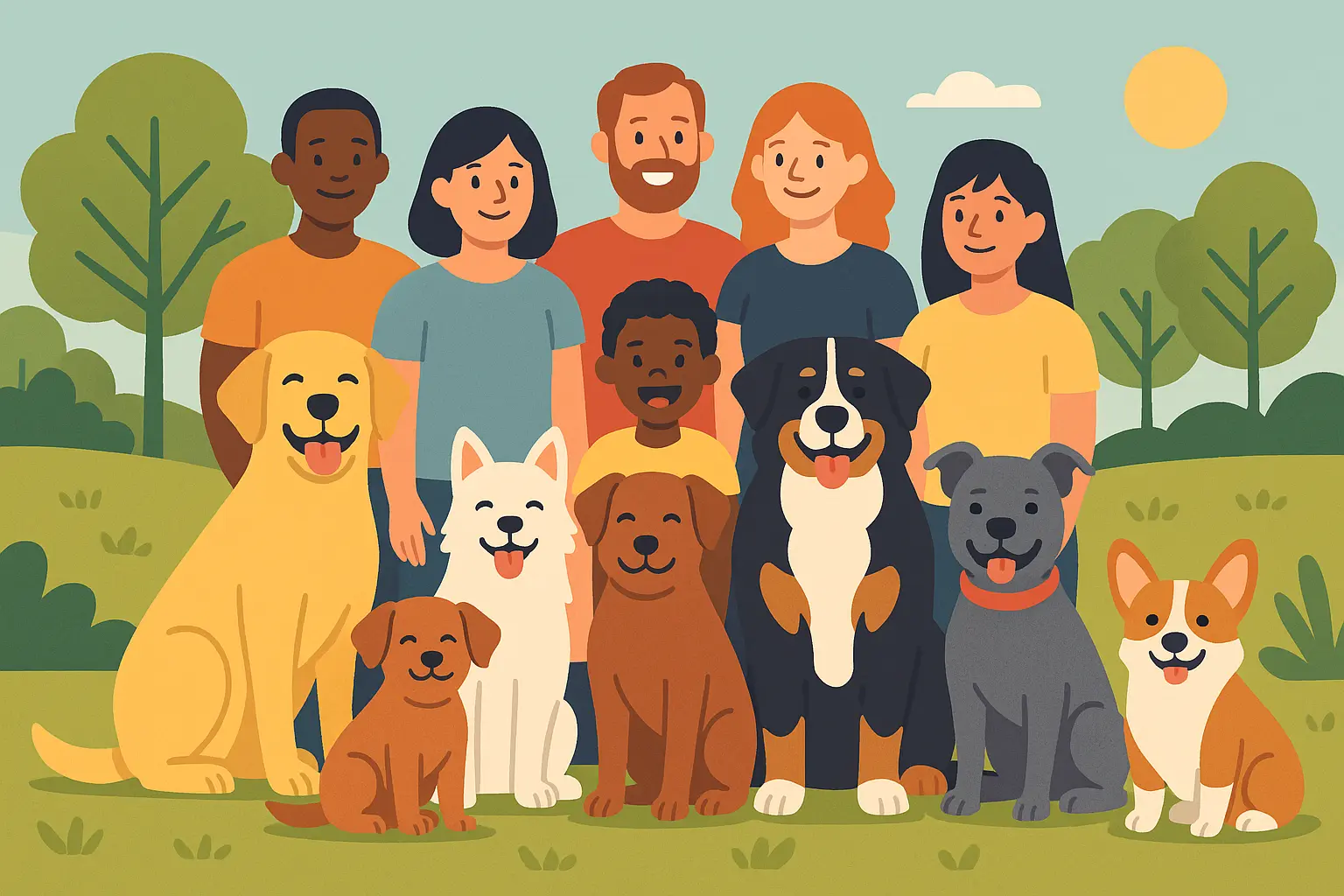
I started this article thinking I’d just compile some feel-good stories. But honestly? Writing about dogs like Hope and Bruno and Dakota reminded me why I started volunteering in the first place. It’s not about being a hero or collecting good karma points. It’s about looking at a scared, broken animal and thinking, “You deserve better.” And then doing something about it.
Pro tip: “Just fostering” is like saying you’re “just looking” at a car lot. My husband said we were only keeping Murphy temporarily. That was three years ago. Don’t tell him I was right.



Add comment